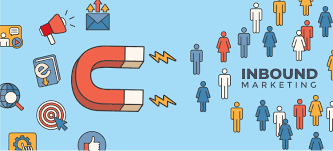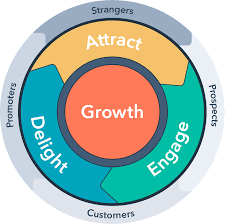18 Inbound Marketing Best Practices for Rapid Growth
In today’s rapidly evolving business landscape, the need to adapt and thrive is more critical than ever. Traditional marketing methods, once deemed effective, are losing their appeal, and customers are increasingly averse to intrusive advertising. This is where inbound marketing steps in to revolutionize the way businesses grow and engage with their audience. In this comprehensive guide, we will delve into the ten inbound marketing best practices that will propel your business towards unprecedented growth.
Understanding the Essence of Inbound Marketing
Inbound marketing is more than just a strategy; it’s a philosophy. At its core, it’s about attracting potential customers through the creation of valuable content and engaging experiences. It involves producing informative blog posts, captivating videos, and compelling social media content. The aim is not to disrupt, but to inform, inspire, and guide your audience.
For instance, instead of bombarding your audience with intrusive advertisements, you might choose to create a blog post that addresses common questions or challenges within your industry. By providing useful information, you are building trust and positioning yourself as an authority in your field, ultimately leading to increased customer loyalty and, consequently, higher sales.
The Imperative of Inbound Marketing for Rapid Growth
Inbound marketing is not just an option; it’s a necessity for businesses seeking rapid growth. Here’s why:

1. Organic Attraction
Inbound marketing focuses on attracting and engaging potential customers organically. By creating valuable and informative content, your business establishes its expertise and builds trust with your target audience. This approach also allows you to tailor your messaging to the specific needs and preferences of your customers, resulting in higher conversion rates.
2. Creating Buyer Personas for Targeted Marketing
Creating buyer personas is a crucial step in targeted marketing. These personas represent your ideal customers and help you understand their needs, preferences, and behaviors. Start by researching your target audience, collecting data on their demographics, interests, and pain points. Use this information to create detailed profiles that include characteristics like age, occupation, goals, and challenges.
By crafting these personas, you can tailor your marketing messages and strategies to address the specific needs of each persona. This targeted approach enhances your connection with your audience and drives more effective marketing campaigns.
3. Understanding Your Ideal Customer Profile
Understanding your ideal customer profile is the bedrock of successful inbound marketing. This involves gathering demographic and psychographic data to create a detailed picture of your target audience. By knowing who your ideal customers are, you can customize your marketing efforts to meet their specific needs and preferences. This includes creating personalized content, targeting the right channels, and designing effective campaigns.
We understand that optimizing creative can be a time-consuming process, and that’s why we’ve invested in our Advantage+ creative suite. With automatic features like templates, 3D motion, depth adjustments, aspect ratio variance, and image and video enhancements, your creative can be fine-tuned in just a few clicks. Our system automatically suggests an optimized version of your creative based on what is predicted to yield the best results.
4. Building an Effective Content Strategy
An effective content strategy starts with identifying your target audience and their needs. Thorough research is essential to understand their interests, pain points, and preferred content formats. This information is used to create buyer personas that will guide your content creation and distribution efforts.
Next, define your goals and objectives, such as increasing brand awareness or generating leads. Develop a content calendar to plan and organize your content production, ensuring a consistent flow of valuable and relevant content.
Finally, measure and analyze the performance of your content to identify areas for improvement and optimize your strategy over time.
5. Creating Valuable and Relevant Content
The heart of successful inbound marketing is creating valuable and relevant content. You must understand your target audience’s needs and interests to deliver content that resonates with them. This can be achieved through thorough research, analyzing customer feedback, and studying industry trends. By providing educational, informative, and entertaining content, you can attract and engage your audience, ultimately building trust and credibility for your brand.
6. Optimizing Your Website for Search Engines
Optimizing your website for search engines is a cornerstone of successful inbound marketing. This process involves making your site easy for search engines to understand and index, which, in turn, improves your chances of ranking higher in search results.
Start by conducting keyword research to identify the relevant terms your target audience is searching for. Then, optimize your website’s content, meta tags, URLs, and headings with these keywords. It’s also crucial to ensure that your website is mobile-friendly since Google penalizes sites that aren’t.
Regularly monitor and analyze your site’s performance using tools like Google Analytics to identify areas for improvement and stay ahead of your competition.

7. Implementing On-Page SEO Techniques
Effective on-page SEO techniques are essential for inbound marketing success. This entails optimizing various elements on your website to enhance its visibility and ranking in search engine results. One effective technique is to optimize title tags, meta descriptions, and headings with relevant keywords.
Additionally, incorporating internal links and creating unique, high-quality content can boost your site’s credibility and authority. Another strategy is to optimize images by using descriptive file names and alt tags. By implementing these on-page SEO techniques, your business can enhance its chances of attracting organic traffic and reaching its target audience effectively.
8. Leveraging Social Media for Brand Awareness and Engagement
Social media is a powerful tool for boosting brand awareness and engagement. With billions of active users, platforms like Facebook, Instagram, and Twitter offer immense potential for reaching and connecting with your target audience. By creating compelling content and actively engaging with your followers, you can increase your brand’s visibility and foster a sense of community around your business.
Collaborating with influencers or using relevant industry hashtags can help amplify your brand’s reach and engagement. It’s essential to track and analyze your social media metrics to identify what strategies are working and make data-driven decisions to optimize your efforts.
9. Creating a Strong Social Media Presence
A strong social media presence is vital for maintaining brand consistency and engaging your audience effectively. To achieve this, consider the following best practices:
Consistent Branding: Use the same logo, color scheme, and tone of voice across all social media platforms to establish a strong brand identity.
Engage with Your Audience: Respond to comments, messages, and mentions promptly to show that you value your followers’ input and are actively listening to them.
Share Valuable Content: Provide informative and relevant posts that address your audience’s pain points or interests to establish yourself as an industry thought leader.
Use Visuals: Include eye-catching images or videos in your posts to make your content more engaging and shareable.
Utilize Hashtags: Use relevant and popular hashtags to increase the visibility of your posts and reach a wider audience.
Analyze and Adapt: Regularly track your social media metrics to identify what is and isn’t working. Adjust your strategy accordingly to improve your social media presence over time.

10. Implementing Email Marketing Strategies
Implementing effective email marketing strategies involves creating targeted and personalized campaigns to engage and nurture leads. Start by building a quality email list with opt-in forms on your website and social media channels. Segment your list based on customer demographics, interests, and behaviors. Tailor your content to each segment, delivering relevant and valuable information. Use automation to send personalized follow-up emails based on customer actions or inaction.
Regularly track open rates, click-through rates, and conversions to measure the success of your campaigns and make improvements. Remember to comply with email regulations and provide easy opt-out options.
11. Segmenting Your Email List for Personalized Campaigns
Segmenting your email list is crucial for running personalized campaigns in inbound marketing. By dividing your subscribers into smaller, targeted groups based on specific characteristics or behaviors, you can tailor your content and offers to their individual needs.
For example, segmenting based on demographics allows you to send relevant messages to different age groups or locations. Behavioral segmentation, on the other hand, helps you target subscribers who have shown particular interests or engagement with your previous campaigns. This allows for a more personalized and effective approach, increasing the chances of engagement and conversions.
12. Utilizing Marketing Automation Tools
Utilizing marketing automation tools can greatly enhance your inbound marketing efforts. These tools help streamline and automate various marketing tasks, allowing you to save time and increase efficiency. For instance, you can automate email campaigns, lead nurturing, and social media postings, ensuring your audience receives the right message at the right time.
Moreover, marketing automation tools provide valuable insights and data, enabling you to understand your audience better and personalize your marketing approach. By leveraging these tools, you can create targeted campaigns, nurture leads effectively, and ultimately drive more conversions for your business.
13. Streamlining Lead Nurturing and Conversion Processes
Streamlining lead nurturing and conversion processes is vital for successful inbound marketing. By automating repetitive tasks and creating targeted workflows, businesses can save time and provide a more personalized experience to prospects.
For example, utilizing automation software allows marketers to automatically send follow-up emails based on specific actions, such as downloading an eBook or attending a webinar. This not only saves effort but also increases the chances of converting leads into customers.
Additionally, integrating marketing and sales platforms enables seamless communication and data sharing, helping teams prioritize and engage with leads more effectively.
14. Creating Landing Pages and Calls-to-Action
Creating compelling landing pages and effective calls-to-action (CTAs) is vital for successful inbound marketing. A well-designed landing page should have a clear objective and be tailored to the target audience. Keep it simple, focusing on a single offer rather than overwhelming visitors with multiple options. Include persuasive copy and eye-catching visuals that highlight the value of the offer.
CTAs should be prominently placed and use action-oriented language to encourage engagement, such as “Download now” or “Get started.” Testing different variations of landing pages and CTAs can identify what resonates best with your audience and result in higher conversion rates.
15. Designing Persuasive Landing Pages to Capture Leads
Designing persuasive landing pages is crucial for capturing leads in inbound marketing. By following these best practices, you can increase your chances of converting visitors into leads:
Clear and Compelling Headline: Grab the attention of your audience with a headline that addresses their pain points or offers a solution.
Compelling Value Proposition: Clearly communicate the unique value your product or service offers to entice visitors to take action.
Concise and Persuasive Copy: Use concise and persuasive copy to convey the key benefits of your offering and make it easy for visitors to understand.
Attention-Grabbing Visuals: Incorporate eye-catching visuals, such as high-quality images or videos, to engage visitors and enhance the overall user experience.
User-Friendly Form: Simplify the lead capture process by designing a form that asks for only essential information and clearly communicates the value of filling it out.
Remember, an effective landing page should be visually appealing, persuasive, and user-friendly to maximize lead conversion rates.
16. Monitoring and Analyzing Performance Metrics
Monitoring and analyzing performance metrics are vital aspects of inbound marketing. They allow you to track the effectiveness of your campaigns and make data-driven decisions for optimization. By measuring key metrics such as website traffic, conversion rates, and engagement levels, you can identify areas of improvement and focus your efforts on strategies that yield the best results.
For example, if a particular landing page has a low conversion rate, you can analyze the data to understand the problem and make necessary adjustments. Regularly monitoring and analyzing performance metrics empowers you to continuously refine your inbound marketing tactics and drive better outcomes.
17. Measuring Success and Making Data-Driven Decisions
Measuring success and making data-driven decisions are fundamental to successful inbound marketing. By analyzing data, marketers can identify what is working and what needs improvement, allowing them to focus their efforts and resources on the most impactful strategies.
For example, tracking website traffic and conversion rates can provide insights into the effectiveness of different marketing campaigns. Similarly, analyzing customer behavior and engagement metrics can help refine target audience personas and tailor content accordingly. By regularly monitoring and interpreting data, marketers can continuously optimize their inbound marketing efforts and drive better results.
CTAs should be prominently placed and use action-oriented language to encourage engagement, such as “Download now” or “Get started.” Testing different variations of landing pages and CTAs can identify what resonates best with your audience and result in higher conversion rates.
18. Continuous Optimization and Experimentation
Continuous optimization and experimentation are fundamental aspects of successful inbound marketing strategies. This involves continuously testing, measuring, and improving various elements of your marketing efforts to maximize their effectiveness. By collecting and analyzing data, you can identify areas for improvement and make data-driven decisions to optimize your campaigns.
For example, you can A/B test different headlines, email subject lines, or landing page designs to determine which version generates higher conversion rates. This iterative approach allows you to fine-tune your marketing tactics, optimize user experiences, and achieve better results over time.
In conclusion, inbound marketing is a potent strategy for achieving rapid business growth. By following these eighteen best practices, businesses can unlock the full potential of inbound marketing and propel themselves towards unprecedented success. It’s a journey of continuous improvement, data-driven decision-making, and a commitment to providing value to your audience. Stay ahead of the curve by staying updated with the latest trends and technologies in the field, and watch your business thrive in the era of inbound marketing.
